Complete Solutions to Single Correct of chapter SUPERPOSITION AND STANDING WAVES of Class 11 book with complete answers and questions
| Class 11 | PHYSICS |
| Chapter | SUPERPOSITION AND STANDING WAVES |
| CENGAGE PHYSICS | Single Correct |
| Number Of Questions | 100 |
| Academic Year | 2023-24 |
The displacement of a particle is given by ` x = 3 sin ( 5 pi t) + 4 cos ( 5 pi t)`. The amplitude of particle is
01:46View SolutionThe equation of displacement of two waves are given as
` y_(1) = 10 sin( 3 pi t + (pi)/(3)) , y_(2) = 5 [ sin 3 pi t + sqrt(3) cos 3 pi t]`
Then what is the ratio of their amplitudes02:34View SolutionOn sounding fork `A` with another tuning fork `B` of frequency `384 Hz , 6 beats` are produced per second .After loading the prongs of `A` with wax and then sounding it again with `B , 4 beats` are produced per second. What is the frequency of the tuning fork `A`.
02:30View SolutionTwo tuning forks `A and B` give ` 4 beats//s` when sounded together . The frequency of `A is 320 Hz`. When some wax is added to `B` and it is sounded with `A , 4 beats//s per second` are again heard . The frequency of `B` is
02:11View SolutionForty - one forks are so arranged that each products ` 5 beat//s` when sounded with its near fork . If the frequency of last fork is double the frequency of first and last fork , respectively are
01:39View SolutionThe equation of a stationary wave is ` y = 0.8 cos ((pi x)/(20)) sin 200 pi t` where ` x` is in cm and t is in s. The separation between consecutive nodes will be
02:26View SolutionThe following equations represent progressive transverse waves
`z_(1) = A cos ( omega t - kx)`
`z_(2) = A cos ( omega t + kx)`
`z_(3) = A cos ( omega t + ky)`
`z_(4) = A cos (2 omega t - 2 ky)`
A stationary wave will be formed by superposing02:26View SolutionTwo pulses in a stretched string whose centres are initially 8 cm apart are moving towards each other as shown in the figure. The speed of each pulse is 2 cm/s. After 2 second, the total energy of the pulses will be
 01:36View Solution
01:36View SolutionTwo identical sounds `s_(1) and s_(2)` reach at a point P phase. The resultant loudness at a point P is not higher than the loudness of `s_(1)`. The value of n is
01:47View SolutionThe ratio of intensities between two cohernt sound sources is 4:1. The difference of loudness is decibel (bD) between maximum and minimum intensitiesm, when they interface in space is
02:25View SolutionMark the correct statement.
02:31View SolutionWhich of the following statements is correct for stationary waves
01:51View SolutionA sound wave of wavelength ` lambda` travels towards the right horizontally with a velocity `V`. It strikes and reflects from a vertical plane surface , travelling at a speed `v` towards the left . The number of positive crests striking in a time interval of `3 s` on the wall is
03:04View SolutionA sonometer wire of length `l` vibrates in fundamental mode when excited by a tunning fork of frequency 416 Hz. If the length is double keeping other things same the string will
02:14View SolutionTwo closed - end pipes , when sounded together produce ` 5 beats//s`. If their lengths are in the ratio `100 : 101` , then fundamental notes ( in Hz) produced by them are
02:50View SolutionVelocity of sound in air is `320 m//s`. The resonant pipe shown in Fig. 7.81 cannot vibrate with a sound of frequency .
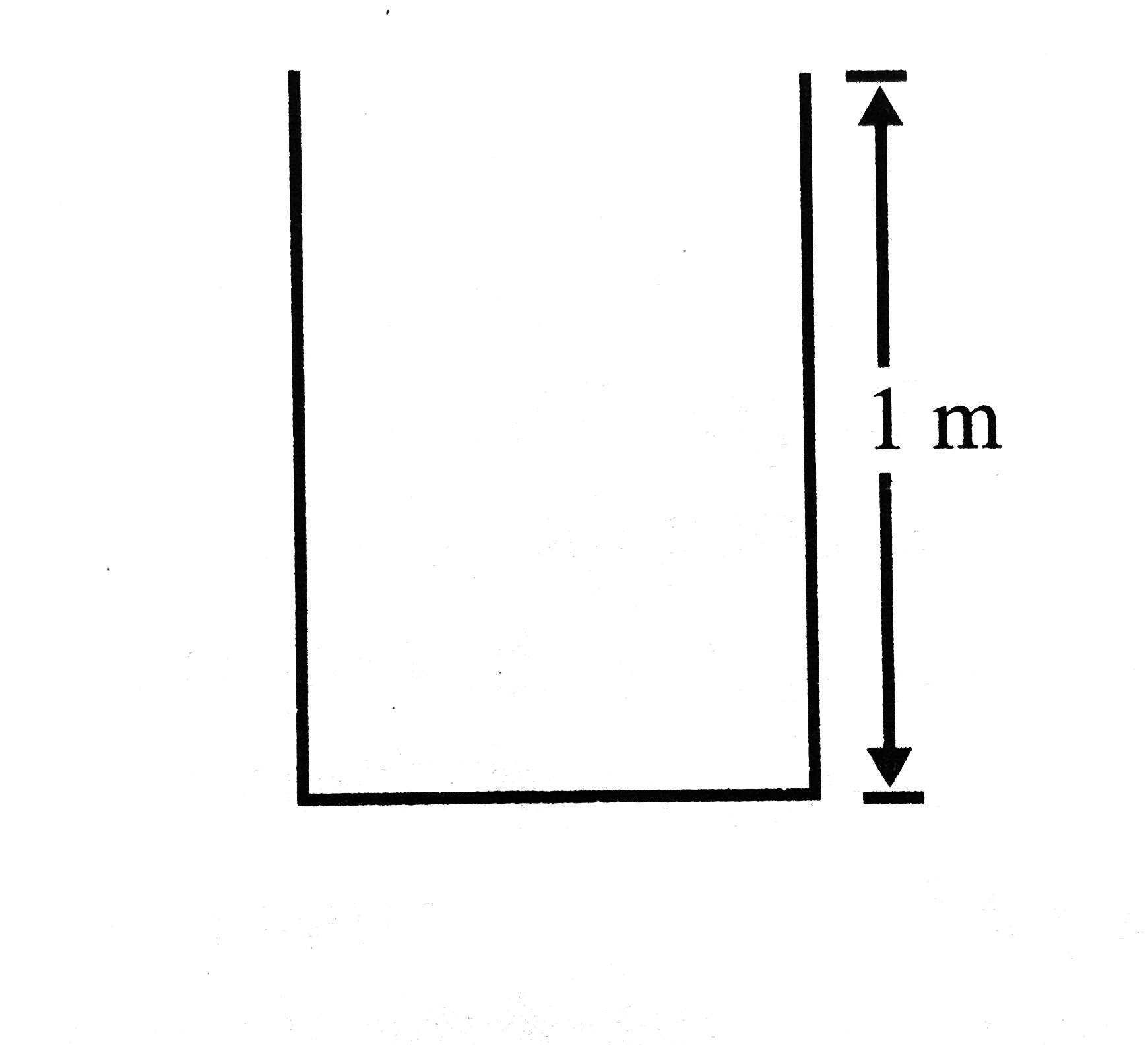 01:28View Solution
01:28View SolutionWaves of frequency `1000 Hz` are produced in a Kundt's tube . The total distance between `6` successive nodes is `82.5 cm`. The speed of sound in the gas filled in the tube is
01:39View SolutionIn a Kundt's tube , the length of the iron rod is `1 m`. The stationary waves frequency `2500 Hz` are produced in it. The velocity of sound in iron is
01:17View SolutionTwo strings A and B made of same material are stretched by same tension. The radius of string A is double of the radius of B. A transverse wave travels on A with speed `v_A` and on B with speed `v_B`. The ratio `v_A/v_B` is
02:37View SolutionA closed organ pipe and an open organ pipe have their first overtones identical in frequency. Their lenghts are in the ratio
02:15View SolutionTwo organ pipe , both closed at one end , have lengths `l and l + Delta l`. Neglect end corrections. If the velocity of sound in air is `V`, then the number of beats//s` is
01:48View SolutionA closed tube has a frequency n. If its length is doubled and radius is halved its frequency will become
02:45View SolutionIn a resonance tube experiment , the first resonance is obtained for `10 cm` of air column and the sound for `32 cm`. The end correction for this apparatus is
03:16View SolutionTwo waves having intensity `I and 9I` produce interference . If the resultant intensity at a point is `7 I`, what is the phase difference between the two waves ?
01:38View SolutionA sonometer wire , `100 cm` in length has fundamental frequency of `330 Hz`. The velocity of propagation of tranverse waves along the wire is
01:26View SolutionIn a resonance column experiment , the first resonance is obtained when the level of the water in the tube is at `20 cm` from the open end . Resonance will also be obtained when the water level is at a distance of
02:15View SolutionA long glass tube is held vertically in water. A tuning fork is struck and held over the tube. Strong resonances are observed at two successive lengths 0.50 m and 0.84 m above the surface of water. If velocity of sound is `340 m s^(-1)`, then the frequency of the tuning fork is
03:21View SolutionA glass tube of `1.0 m` length is filled with water . The water can be drained out slowly at the bottom of the tube . If a vibrating tuning fork of frequency `500 c//s` is brought at the upper end of the tube and the velocity of sound is `330 m//s`, then the total number of resonances obtained will be
03:38View SolutionWhen the string of a sonometer of length `L` between the bridges vibrates in the first overtone , the amplitude of vibration is maximum at
01:59View SolutionA standing tuning fork of frequency `f` is used to find the velocity of sound in air by resonance column appartus. The difference two resonating lengths is `1.0 m`. Then the velocity of sound in air is
02:07View SolutionA sufficiently long closed organ pipe has a small hole at its bottom. Initially the pipe is empty. What poured into the pipe at a constant rate. The fundamental frequency of the air column in the pite
02:01View SolutionAn open pipe resonates with a tuning fork of frequency `500 Hz` . It is observed that two successive notes are formed at distance `16 and 46 cm` from the open end. The speed of sound in air in the pipe is
01:57View SolutionIf the length of a stretched string is shortened by `40 %` and the tension is increased by `44 %`, then the ratio of the final and initial fundamental frequencies is
02:18View SolutionTwo uniform strings `A and B` made of steel are made to vibrate under the same tension. If the first overtone of `A` is equal to the second overtone of `B` and if the radius of `A` is twice that of `B`, the ratio of the lengths of the strings is
04:06View SolutionA somoneter wire resonates with a given tuning fork forming standing waves with five antindoes between the two bridges when a mass of 9 kg is suspended from the wire. Resonates with the same tuning fork forming three antindoes for the same postions of the bridges. the value of M is
02:58View SolutionIn a large room , a person receives direct sound waves from a source 120 metres away from him. He also receives waves from the same source which reach , being reflected from the `25 m` high ceiling at a point halfway between them . The two waves interfere constructively for a wavelength of
02:36View SolutionTwo waves are passing through a region in the same direction at the same time . If the equation of these waves are
`y_(1) = a sin ( 2pi)/(lambda)( v t - x)`
and `y_(2) = b sin ( 2pi)/( lambda) [( vt - x) + x_(0) ]`
then the amplitude of the resulting wave for `x_(0) = (lambda//2)` is03:24View SolutionThe vibrations of a string of length 60 cm fixed at both ends are represented by the equation `y=4sin((pix)/15) cos (96 pi t)`, where x and y are in cm and t in seconds.
(a)What is the maximum displacement of a point at `x = 5cm`?
(b)Where are the nodes located along the string?
(c)What is the velocity of the particle at x=7.5cm and t=0.25s?
(d)Write down the equations of the component waves whose superposition gives the above wave.07:42View SolutionTwo instruments having stretched strings are being played in unison . When the tension in one of the instruments is increases by ` 1% , 3` beats are produced in ` 2 s`. The initial frequency of vibration of each wire is
02:28View SolutionThe displacement `xi` in centimetres of a particle is `xi = 3 sin 314 t + 4 cos 314 t`. Amplitude and initial phase are
02:34View SolutionA stretched string of length ` 1 m` fixed at both ends , having a mass of `5 xx 10^(-4) kg` is under a tension of `20 N`. It is plucked at a point situated at `25 cm` from one end . The stretched string would vibrate with a frequency of
02:00View SolutionA sonometer wire supports a 4 kg load and vibrates in fundamental mode with a tunig fork of frequency 416 Hz. The length of the wire between the bridges is now doubled. In order to maintain fundamental mode, the load should be changed to
02:59View SolutionA piano wire having a diameter of `0.90 mm` is replaced by another wire of the same material but with a diameter of `0.93 mm`.If the tension of the wire is kept the same , then the percentage change in the frequency of the fundamental tone is
03:13View SolutionIn the sonometer experiment , a tuning fork of frequency `256 Hz` is in resonance with `0.4 m` length of the wire when the iron load attached to free end of wire is `2 kg`. If the load is immersed in water , the length of the wire in resonance would be ( specific gravity of iron ` = 8`)
03:29View SolutionAn air column in a pipe, which is closed at one end, will be in resonance with a vibaring tuning fork of frequency 264 Hz, if the length of the column in cm is (Speed of sound = 330 m/s)
04:34View SolutionIf `v_(1) , v_(2) and v_(3)` are the fundamental frequencies of three segments of stretched string , then the fundamental frequency of the overall string is
05:03View SolutionAn organ pipe `P_(1)` closed at one end vibrating in its first harmonic and another pipe `P_(2)` open at both ends vibrating in its third harmonic are in resonance with a given tuning fork. The ratio of the length of `P_(1)` and `p_(2)` is
(a) `8//3` (b) `3//8` (c ) `1//6` (d) `1//3`02:34View SolutionTwo vibrating tuning forks produce progressive waves given by , `y_(1) = 4 sin (500 pi t) and y_(2) = 2 sin (506 pi t)`. These tuning forks are held near the ear of person . The person will hear
02:40View SolutionA metal rod `40 cm` long is dropped on to a wooden floor and rebounds into air . Compressional waves of many frequencies are thereby set up in the rod . If the speed of compressional waves in the rod in `5500 m//s`, what is the lowest frequency of compressional waves to which the rod resonates as it rebounds?
01:57View SolutionA wave of frequency 100 Hz is sent along a string towards a fixed end. When this wave travels back after reflection, a node is formed at a distance of 10 cm frome the fixed end of the string. The speed of incident (and reflected) wave are
02:10View SolutionA sound wave starting from source `S`, follows two paths `AOB and ACB` to reach the detector `D`. If `ABC` is an equilateral traingle , of side `l` and there is silence at point `D`, the maximum wavelength `(lambda)` of sound wave must be
 03:46View Solution
03:46View SolutionTwo standing bodies producing progressive waves are given by
` y_(1) = 4 sin 400 pi t and y_(2) = 3 sin 404 pi t`
One of these bodies situated very near to the ears of a person who will hear :05:14View SolutionTen tuning forks are arranged in increasing order of frequency is such a way that any two nearest tuning forks produce `4 beast//sec`. The highest freqeuncy is twice of the lowest. Possible highest and the lowest frequencies are
02:16View SolutionA long cylindrical tube carries a highly polished piston and has a side opening . A tuning fork of frequency `n` is sounded at the open end of the tube . The intensity of the sounded heard by the listener changes if the piston is moved in or out. At a particular position of the piston he hears a maximum sound . When the piston is moved through a distance of `9 cm`, the intensity of sound becomes minimum. If the speed of sound is `360 m//s`, the value of `n` is
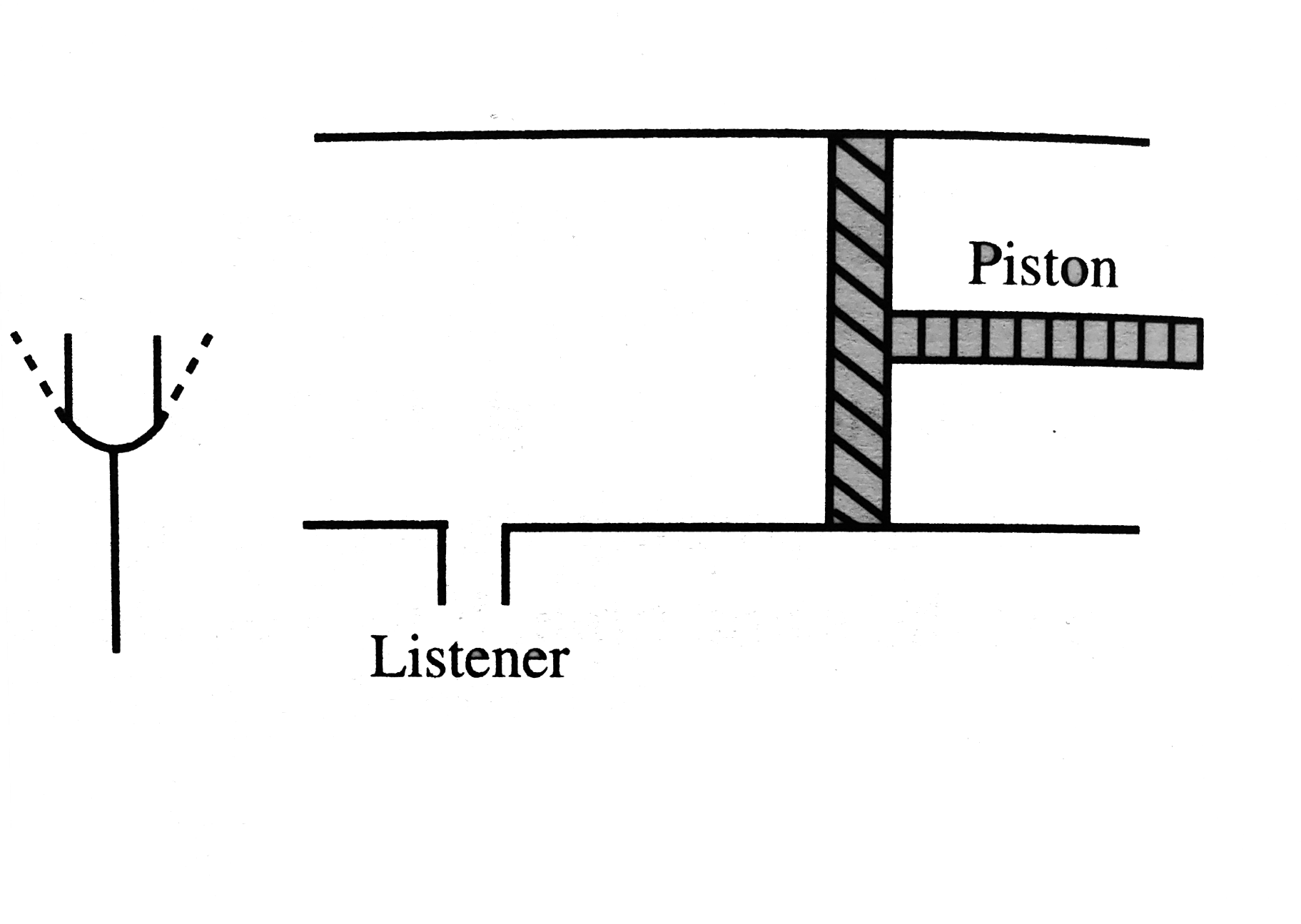 03:33View Solution
03:33View SolutionA sound wave of wavelength `0.40 m` enters the tube at `S`. The smallest radius `r` of the circular segment to hear minimum at detector `D` must be
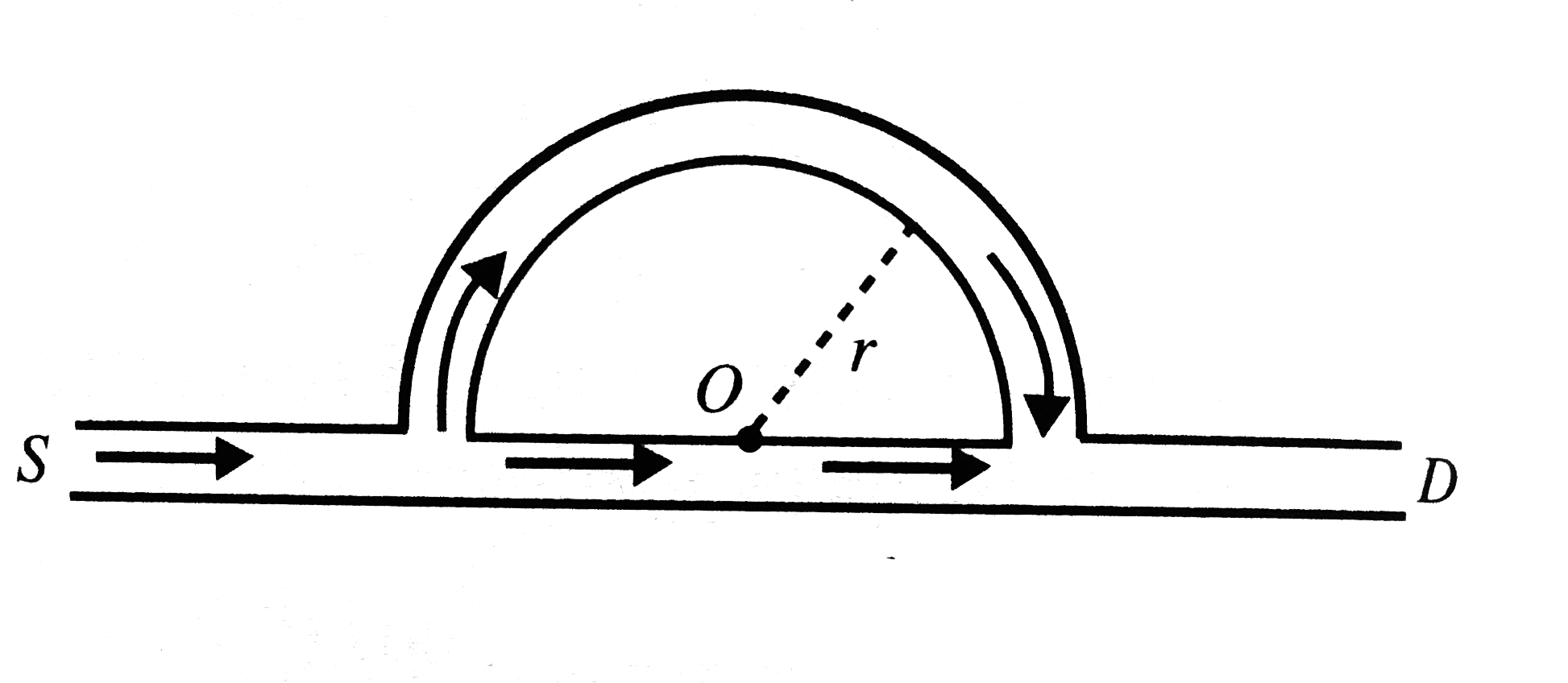 02:47View Solution
02:47View SolutionA sound wave starting from source `S`, follows two paths `SEFD and SEABFD`. If `AB = 1 , AE = BF = 0.6 l ` and wavelength of wave is `lambda = 6 m`. If maximum sound is heard at `D` , then maximum value of length `l` is
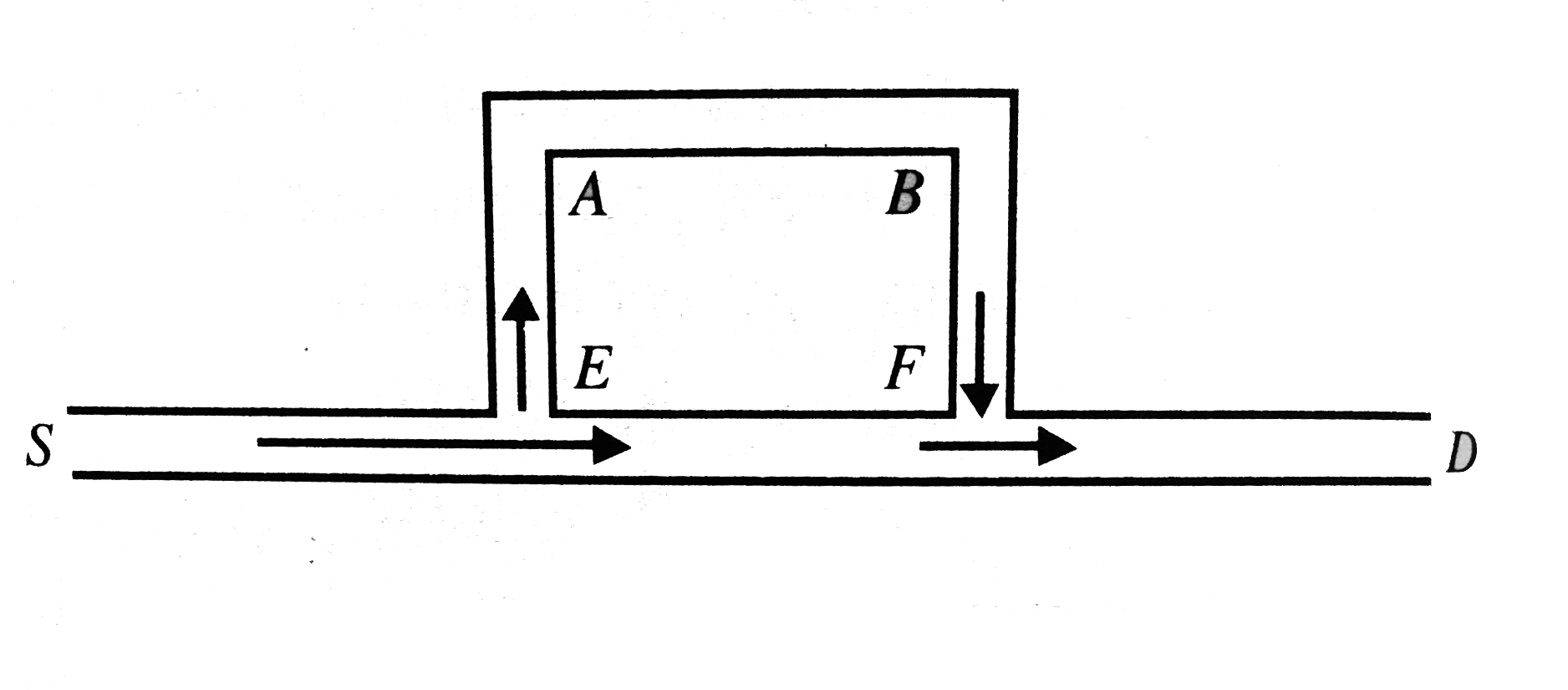 02:18View Solution
02:18View SolutionAn organ pipe `A` closed at one end vibrating in its fundamental frequency and another pipe `B` open at both ends is vibrating in its second overtone are in resonance with a given tuning fork . The ratiio of length of pipe `A` to that of `B` is
01:17View SolutionThe displacement `y` of a particle executing periodic motion is given by `y = 4 cos^(2) ((1)/(2)t) sin(1000t)`
This expression may be considereed to be a result of the superposition of03:58View SolutionTwo identical straight wires are stretched so as to products `6 beats// s` when vibrating simultaneously. On changing the tension slightly in one of them, the beat frequency remains unchanged. Denoting by , `T_(1)` the higher and `T_(2)` the lower, initial tensions in the strings, then it could be said that that while making the above changes in tension
05:18View SolutionAn open pipe of length ` 2m` is dipped in water . To what depth ` x` is to be immersed in water so that it may resonate with a tuning fork of frequency `170 Hz` when vibrating in its overtone . Speed of sound in air is `340 m//s`
02:54View SolutionA stone is hung in air from a wire which is stretched over a sonometer. The bridges of the sonometer are 40 cm apart when the wire is in unison with a tuning fork of frequency 256. when the stone is completely immersed in water , the length between the bridges is 22 cm for re- establishing unison. the specific gravity of the material of the stone is
03:20View SolutionA stretched wire of stone length under a tension is vibrating with its fundamental frequency . Its length is decreased by `45 %` and tension is increased by `21 %` . Now fundamental frequency
03:49View SolutionAn open and a closed pipe have same length ratio of frequencies of their nth overtone is
02:10View SolutionA string is stretched so that its length is increased by `1/eta` of its original length. The ratio of fundamental frequency of transverse vibration to that of fundamental frequency of longitudinal vibration will be
02:07View SolutionA closed organ pipe and an open organ pipe of some length produce ` 2 beats ` when they are set up into vibration simultaneously in their fundamental mode . The length of the open organ pipe is now halved and of the closed organ pipe is doubled , the number of beats produced will be a) 7 b) 4 c) 8 d) 2
02:42View Solutionthe frequency of a sonometer wire is 10 Hz. When the weight producing th tensions are completely immersed in water the frequency becomes 80 Hz and on immersing the weight in a certain liquid the frequency becomes 60 Hz. The specific gravity of the liquid is
04:27View SolutionAn open organ pipe of length l is sounded together with another open organ pipe of length l + x in their fundamental tones. Speed of sound in air is v. the beat frequency heard will be (`x lt lt l`)
02:32View Solution`n` waves are produced on a string in ` 1 s` . When the radius of the string is doubled and the tension is maintained the same , the number of waves produced in ` 1 s` for the same harmonic will be
03:00View SolutionThe displacement `y` of a particle periodic motion is given by
`y = 4 cos ((1)/(2) t) sin (1000 t)`
This expression may be considered as a result of the superposition of04:21View SolutionThe minimum intensity of audibility of sound is `10^(-12) W//m^(2) s` and density of air ` = 1.293 kg//m^(3)`. If the frequency of sound in `1000 Hz` , then the corresponding amplitude the vibration of the air particles is
[ Take velocity of sound `= 332 m//s`]06:26View SolutionThe frequency of `B` is `3%` greater than that of `A` . The frequency of `C is 2%` less than that of `A` . If `B and C` produce `8 beats//s`, then the frequency of `A` is
03:35View SolutionOne end of a `2.4 - m`string is held fixed and the other end is attached to a weightless ring that can slide along a frictionless rod as shown in Fig. 7.86. The three longest possible wavelength for standing waves in this string are respectively
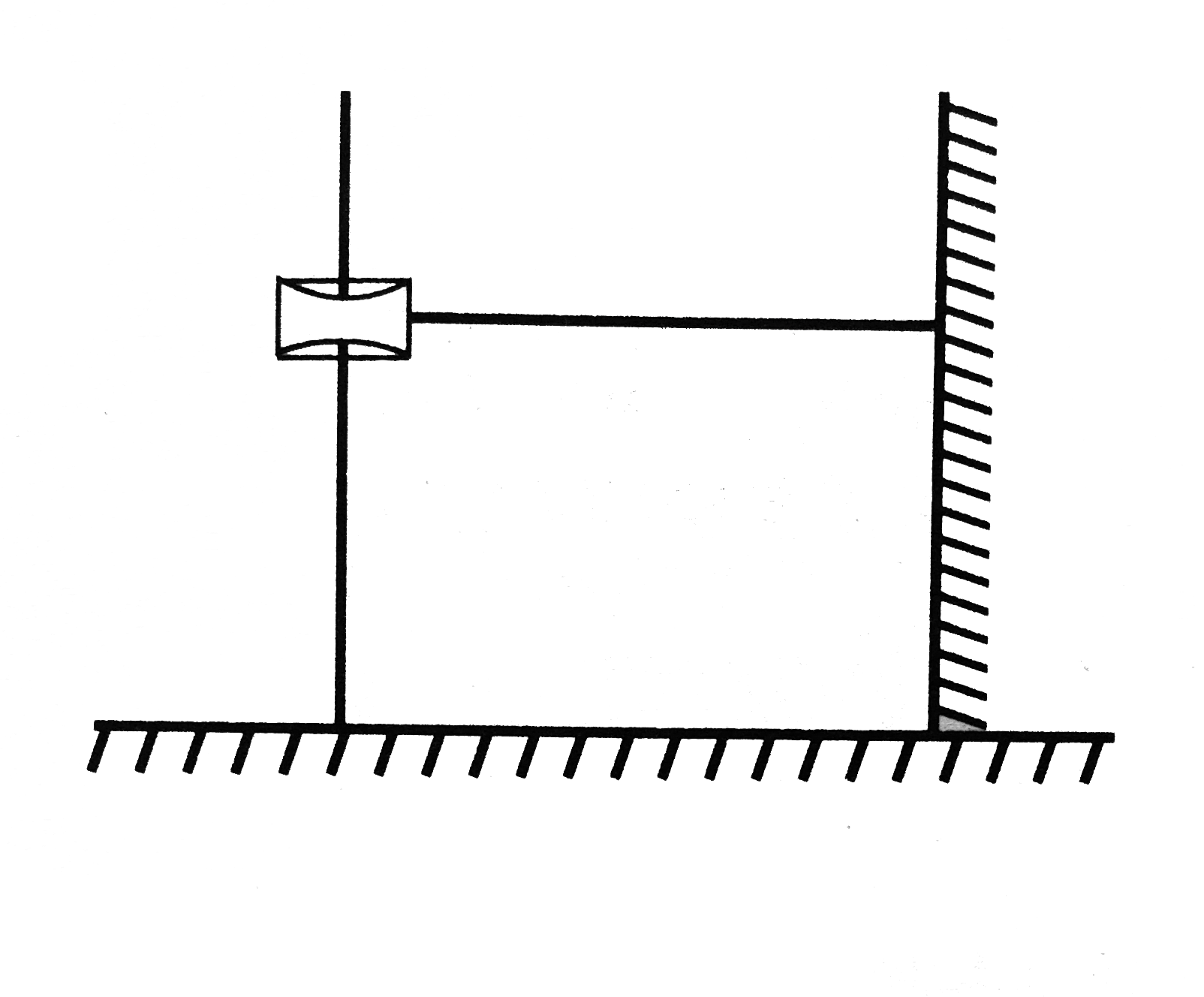 01:23View Solution
01:23View SolutionThe strings of a violin are tuned to the tones `G , D , A and E` which are separated by a fifth from one another . That is `f(D) = 1.5 (G) , f(A) = 1.5 f(D) = 400 Hz and f(E ) = 1.5 f(A)`. The distance between the two fixed points , the bridge at the scroll and over the body of the instrument is `0.25 m`. The tension on the string `E is 90 N`. The mass per unit length of string `E` is nearly
02:23View SolutionFive sinusoidal waves have the same frequency 500 Hz but their amplitudes are in the ratio `2 : (1)/(2) : (1)/(2) : 1 : 1` and their phase angles `0, (pi)/(6), (pi)/(3), (pi)/(2)` and `pi` respectively. The phase angle of resultant wave obtained by the supersposition of these five waves is
08:47View SolutionThe breaking stress of steel is `7.85 xx 10^(8) N//m^(2)` and density of steel is `7.7 xx 10^(3) kg//m^(3)`. The maximum frequency to which a string `1 m` long can be tuned is
01:48View SolutionWhich of the following travelling wave will produce standing wave , with nodes at `x = 0`, when superimosed on ` y = A sin ( omega t - kx)`
02:58View SolutionA wire of length l having tension T and radius `r` vibrates with fundamental frequency `f`. Another wire of the same metal with length `2l` having tension `2T` and radius `2r` will vibrate with fundamental frequency :
02:11View SolutionA string of length 1.5 m with its two ends clamped is vibrating in fundamental mode. Amplitude at the centre of the string is 4 mm. Minimum distance between the two points having amplitude 2 mm is:
02:33View SolutionA `75 cm` string fixed at both ends produces resonant frequencies `384 Hz and 288 Hz` without there being any other resonant frequency between these two . Wave speed for the string is
01:51View SolutionA string of length 'l' is fixed at both ends. It is vibrating in tis 3rd overtone with maximum amplitude 'a' the amplitude at a distance `l/3` from one end is
01:38View SolutionWhat is the percentage change in the tension necessary in a somometer of fixed length to produce a note one octave lower (half of original frequency) than before?
02:08View SolutionA chord attached to a viberating tunning fork divides it into 6loops, when its tension is 36N. The tensin at which it will viberate in 4loops is
03:11View SolutionA closed organ pipe has length `L`. The air in it is vibrating in third overtone with maximum amplitude a . The amplitude at distance`(L)/(7)` from closed of the pipe is a) 0 b) a c) a/2 d) data insufficient
04:06View SolutionWhen a sound wave is reflected from a wall the phase difference between the reflected and incident pressure wave is:
03:47View SolutionA point source is emitting sound in all directions. The ratio of distance of two points from the point source where the difference in loudness levels is 3 dB is: `(log_(10)2=0.3)`.
03:36View SolutionThe frequency of a man's voice is 300 Hz and its wavelength is 1 meter. If the wavelength of a child's voice is 1.5 m, then the frequency of the child's voice is"
01:09View SolutionA sound wave of frequency `440 Hz` is passing through in air. An `O_(2)` molecule `( mass = 5.3 xx 10^(- 26) kg)` is set in oscillation with an amplitude of `10 ^(-6) m`. Its speed at the centre of its oscillation is
01:24View Solution`S_(1)` and `S_(2)` are two coherent sources of sound having no intial phase difference. The velocity of sound is `330 m//s`. No maximum will be formed on the line passing through `S_(2)` and prependicular to the line joining `S_(1)` and `S_(2)`. If the frequency of both the sources is
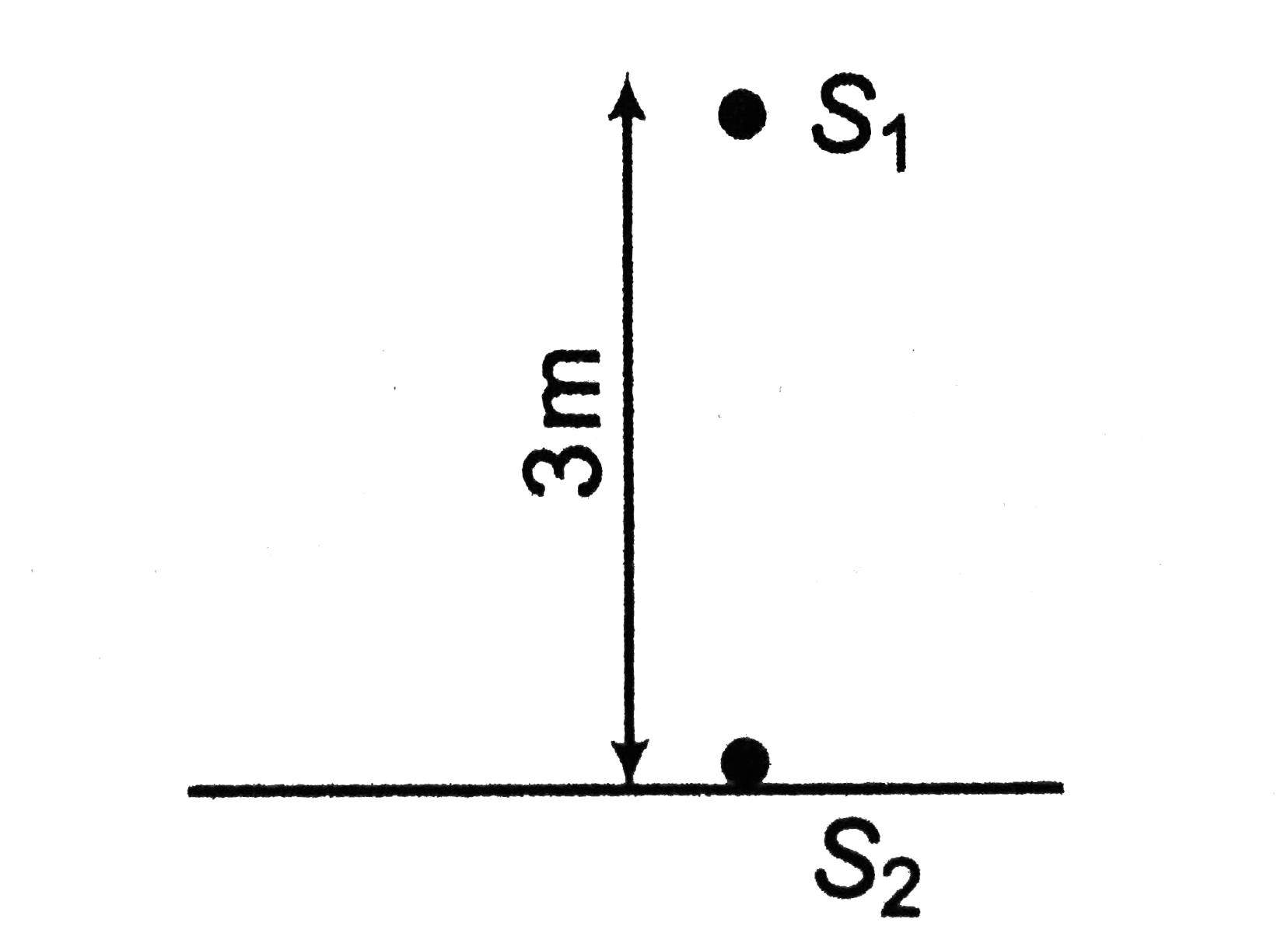 02:00View Solution
02:00View SolutionUnder simuliar conditions of temperature and pressure, in which of the following gases the velocity of sound will be largest?
01:59View SolutionWhen beats are produced by two progressive waves of nearly the same frequency, which one of the following if correct?
03:41View SolutionThere is a set of four tuning forks , one with the lowest frequency vibrating at `550 Hz`. By using any two tuning forks at a time , the following beat frequencies are heard : `1 , 2, 3, 5 , 7 , 8`. The possible frequencies of the other three forks are
07:13View SolutionA `100 - m` long rod of density `10.0 xx 10^(4) kg//m^(3)` and having Young's modulus `Y = 10^(11) Pa`, is clamped at one end . It is hammered at the other free end. The longitudinal pulse goes to right end , gets reflected and again returns to the left end . How much time the pulse take to go back to initial point.
 02:26View Solution
02:26View SolutionFigure 7.88 shows a stretched string of length `L` and pipes of length `L , 2L , L//2 and L//2` in options (a) , (b), (c ) and (d) respectively . The string 's tension is adjusted until the speed of waves on the string equals the speed of sound waves in the air . The fundamental mode of oscillation is the set up on the string . In which pipe will the sound produced by the string cause resonance ?
 02:26View Solution
02:26View SolutionEquations of a stationary and a travelling waves are as follows `y_(1) = sin kx cos omega t` and `y_(2) = a sin ( omega t - kx)`. The phase difference between two points `x_(1) = pi//3k` and `x_(2) = 3 pi// 2k is phi_(1)` in the standing wave `(y_(1))` and is `phi_(2)` in the travelling wave `(y_(2))` then ratio `phi_(1)//phi_(2)` is
02:18View SolutionIn the resonance tube experiment , the first resonance is heard when length of air column is `l_(1)` and second resonance is heard when length of air column is `l_(2)`. What should be the minimum length of the tube so that third resonance can also be heard.
02:03View SolutionMicrowaves from a transmitter are directed toward a plane reflector. A detector moves along the normal to the reflector. Between positions of 14 successive maxima, the detector travels distancee of 0.14 m . What is the frequency of transimitter?
01:52View SolutionA man standing in front of a mountain beats a drum at regular intervals. The drumming rate is gradually increased and he finds that echo is not heard distinctly when the rate becomes `40` per minute. He then moves near to the mountain by `90` metres and finds that echo is again not heard distinctly when the drumming rate becomes `60` per minute. Calculate (a) the distance between the mountain and the initial position of the man and (b) the velocity of sound.
04:05View SolutionLet the two waves `y_(1) = A sin ( kx - omega t)` and `y_(2) = A sin ( kx + omega t)` from a standing wave on a string . Now if an additional phase difference of `phi` is created between two waves , then
01:09View SolutionA standing wave on a string is given by `y = ( 4 cm) cos [ x pi] sin [ 50 pi t]`, where `x` is in metres and t is in seconds. The velocity of the string section at `x = 1//3 m at t = 1//5 s`, is
03:02View SolutionIf the velocity of sound in air is `320 m//s`, then the maximum and minimum length of a pipe closed at one end , that would produce a just audible sound would be
03:16View Solution
Single Correct questions and complete solutions for chapter SUPERPOSITION AND STANDING WAVES of CENGAGE PHYSICS (ENGLISH) of Class 11
